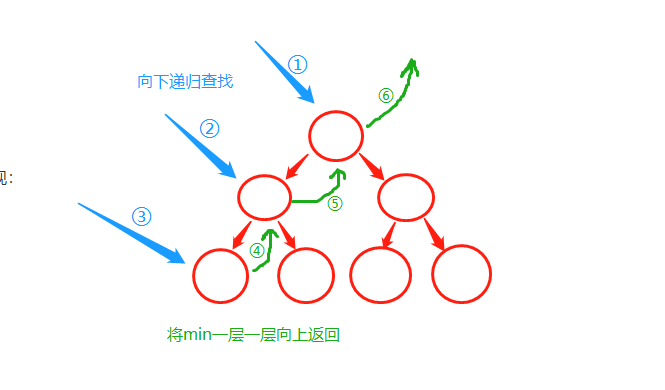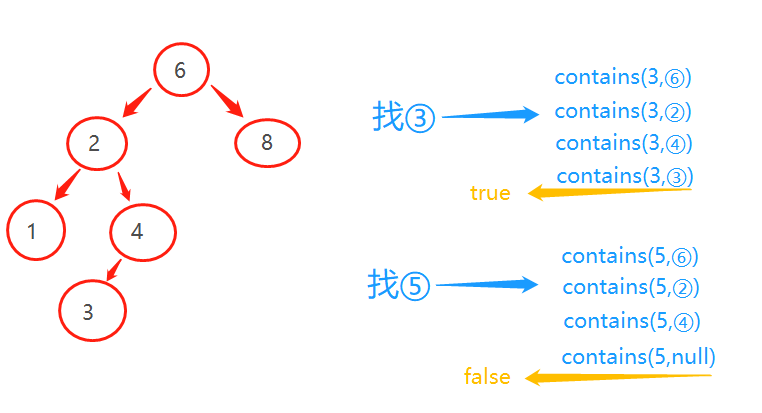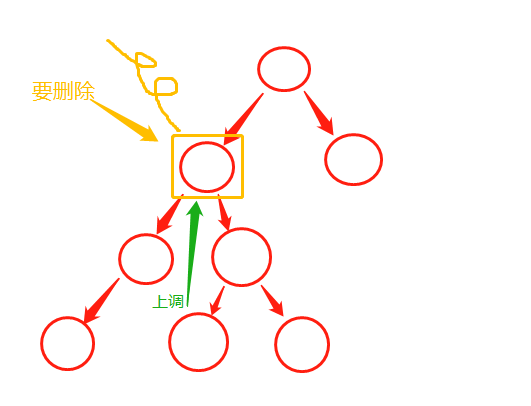用Java实现二叉查找树
2024-09-01 17:23:55
二叉查找树的实现
1. 原理
二叉查找树,又称为二叉排序树、二叉搜索树。对于树中每一个节点X,它的左子树中所有项的值小于X中的项,而它的右子树中所有项的值大于X中的项。二叉查找树的平均深度为O(log N),搜索元素的时间复杂度也是O(log N)。是两种库集合类TreeSet、TreeMap实现的基础。
2. public API
void makeEmpty( ) --> 置空
boolean isEmpty( ) --> 判空
AnyType findMin( ) --> 寻找最小值
AnyType findMax( ) --> 寻找最大值
boolean contains( x ) --> 是否存在元素x
void insert( x ) --> 插入元素x
void remove( x ) --> 删除元素x
void printTree( ) --> 遍历二叉树
3. 核心思想图解:递归
!寻找最小值
此处用递归实现:

!寻找最大值
此处用非递归实现,也可以用递归实现:

!是否存在元素x
从root开始往下找,找到含有项X的节点,则此操作返回true,没有找到则返回false。

!插入元素x
从root开始往下找到合适的插入位置,然后插入。

!删除元素x
从root开始往下找到元素x,找到则删除,并且处理好后续工作。

4. BinarySearchTree代码实现
类中,大量使用方法来调用递归方法的技巧,很好地体现了面向对象的封装性。
/**
* @author: wenhx
* @date: Created in 2019/10/8 19:41 (之前)
* @description: 二叉查找树的实现
*/
public class BinarySearchTree<AnyType extends Comparable<? super AnyType>> {
/**
* 树的根节点
*/
private BinaryNode<AnyType> root;
/**
* 定义树的节点(内部类)
*/
private static class BinaryNode<AnyType> {
AnyType element; // 元素值
BinaryNode<AnyType> left; // 左孩子
BinaryNode<AnyType> right; // 右孩子
// 节点的构造器:初始化一个树的节点
BinaryNode(AnyType theElement) {
this(theElement, null, null);
}
BinaryNode(AnyType theElement, BinaryNode<AnyType> lt, BinaryNode<AnyType> rt) {
element = theElement;
left = lt;
right = rt;
}
}
/**
* 二叉排序树的构造器:初始化根节点
*/
public BinarySearchTree() {
root = null;
}
/**
* 置空
*/
public void makeEmpty() {
root = null;
}
/**
* 判空
*/
public boolean isEmpty() {
return root == null;
}
/**
* 寻找最小值
*/
public AnyType findMin() {
if (isEmpty()) {
throw new RuntimeException();
}
return findMin(root).element;
}
/**
* 寻找最大值
*/
public AnyType findMax() {
if (isEmpty()) {
throw new RuntimeException();
}
return findMax(root).element;
}
/**
* 是否存在元素x
*/
public boolean contains(AnyType x) {
return contains(x, root);
}
/**
* 插入元素x
*/
public void insert(AnyType x) {
root = insert(x, root);
}
/**
* 删除元素x
*/
public void remove(AnyType x) {
root = remove(x, root);
}
/**
* 遍历此二叉树
*/
public void printTree() {
if (isEmpty()) {
System.out.println("Empty tree");
} else {
printTree(root);
}
}
/**
* 寻找最小值(内部方法):此处用递归实现
*/
private BinaryNode<AnyType> findMin(BinaryNode<AnyType> t) {
if (t == null) {
return null;
} else if (t.left == null) {
return t;
}
return findMin(t.left);
}
/**
* 寻找最大值(内部方法):此处用非递归实现
*/
private BinaryNode<AnyType> findMax(BinaryNode<AnyType> t) {
if (t != null) {
while (t.right != null) {
t = t.right;
}
}
return t;
}
/**
* 是否存在元素x(内部方法)
*/
private boolean contains(AnyType x, BinaryNode<AnyType> t) {
/**
* 跳出递归的条件
*/
if (t == null) {
return false;
}
/**
* 如果x小于节点值,则递归到左孩子;
* 如果x大于节点值,则递归到右孩子;
* 如果x等于节点值,则找到。
*/
int compareResult = x.compareTo(t.element);
if (compareResult < 0) {
return contains(x, t.left);
} else if (compareResult > 0) {
return contains(x, t.right);
} else {
return true;
}
}
/**
* 插入元素x(内部方法)
*/
private BinaryNode<AnyType> insert(AnyType x, BinaryNode<AnyType> t) {
/**
* 跳出递归的条件
*/
if (t == null) {
return new BinaryNode<>(x, null, null);
}
/**
* 如果x小于节点值,则递归到左孩子;
* 如果x大于节点值,则递归到右孩子;
* 如果x等于节点值,则说明已有元素x,无需操作。
*/
int compareResult = x.compareTo(t.element);
if (compareResult < 0) {
t.left = insert(x, t.left);
} else if (compareResult > 0) {
t.right = insert(x, t.right);
} else {
}
return t;
}
/**
* 删除元素x(内部方法)
*/
private BinaryNode<AnyType> remove(AnyType x, BinaryNode<AnyType> t) {
/**
* 跳出递归的条件
*/
if (t == null) {
return t; // Item not found; do nothing
}
/**
* 如果x小于节点值,则递归到左孩子;
* 如果x大于节点值,则递归到右孩子;
* 如果x等于节点值,则要删除此节点。
*/
int compareResult = x.compareTo(t.element);
if (compareResult < 0) {
t.left = remove(x, t.left);
} else if (compareResult > 0) {
t.right = remove(x, t.right);
} else if (t.left != null && t.right != null) {
// 要删除的节点有两个孩子(可选用右孩子最小元素/左孩子最大元素上调)
t.element = findMin(t.right).element;
t.right = remove(t.element, t.right);
} else {
// 要删除的节点有一个孩子或者没有孩子
t = (t.left != null) ? t.left : t.right;
}
return t;
}
/**
* 遍历此二叉树(内部方法)
*/
private void printTree(BinaryNode<AnyType> t) {
// 中序遍历-->即递增顺序
if (t != null) {
printTree(t.left);
System.out.println(t.element);
printTree(t.right);
}
}
/**
* 求树的深度(内部方法)
*/
private int height(BinaryNode<AnyType> t) {
if (t == null) {
return -1;
} else {
return 1 + Math.max(height(t.left), height(t.right));
}
}
/**
* 主方法用来测试
*/
public static void main(String[] args) {
BinarySearchTree<Integer> t = new BinarySearchTree<>();
t.insert(6);
t.insert(3);
t.insert(9);
t.insert(2);
t.insert(5);
t.insert(8);
t.insert(10);
t.printTree();
t.insert(4);
}
}
okay,今天就到这啦,一定要掌握这种数据结构哈,真的很重要!!!
最新文章
- Github团队开发集成以及eclipse集成
- spark on yarn 提交任务出错
- C++中随机数和不重复的随机数
- 又一次的Microsoft Visual C++ 10.0 is required (Unable to find vcvarsall.bat)
- supersr--图片轮播逻辑
- 获取UILabel宽度的方法
- [Windows] 批处理文件系统服务控制
- FileCopy
- UIView 翻转动画
- PowerDesigner(三)-企业架构模型(转)
- js判断输入是否为空,获得输入的类型
- cocos2d-x 详解之 CCSprite(精灵)- “CCSpriteBatchNode”和“CCSpriteFrameCache”
- slots - Python的结构体 转
- [EAP]将hostapd作为radius服务器搭建EAP认证环境
- hadoop文本转换为序列文件
- Java线程的六种状态
- springboot项目生成jar包(带静态资源)方法
- 设置ip地址、掩码、网关、DNS
- JavaScipt测试调研
- tensorflow 安装GPU版本,个人总结,步骤比较详细【转】